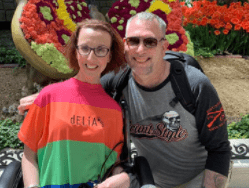The Challenge: Drug-Resistant Epilepsy
Jessica McCoy was a healthy 20-year-old working as a nurses' aide in New Wilmington, Pennsylvania, when she had her first seizure in 1999.
“I was just standing in our kitchen," she says. “Next thing I remember is waking up in the hospital and being told I had epilepsy."
What followed was 21 years of suffering with seizures that could not be controlled by medicines.
Nearly 40% of people with epilepsy don't respond to standard antiseizure medicines. Known as drug-resistant epilepsy, it can be challenging to manage.
"This is the longest I've been seizure-free in 21 years." — Jessica, now 41
Schedule an Appointment or Ask a Question
“I was just living with the seizures," says Jessica. “I'd wake up every morning hoping my meds would work that day."
Sometimes, they did, but more often, they didn't.
The nighttime seizures were especially hard on her husband, James, a registered nurse.
“I could be hurting myself — biting and chewing the inside of my mouth and my tongue — but never wake up," she says. James would wake up, she says, and he'd wake Jessica to help tend to the injuries. "My husband had the toughest part for all those years," says Jessica.
In 2006, a non-UPMC doctor recommended right temporal lobectomy surgery to help control the seizures. Just after the procedure began, a devastating complication occurred:
“I had a stroke that left me permanently paralyzed on the left side of my body," says Jessica.
Recovering from the stroke — and still plagued by the seizures — was a grueling process that took every ounce of her strength and focus.
“I even had to learn to feed myself again," says Jessica.
The Solution: Additional Surgery at UPMC
Jessica never gave up hope of someday finding a way to control her seizures.
“I know people with epilepsy can lead normal lives," she says.
In 2015, Jessica underwent right temporal lobectomy surgery at UPMC. From her perspective, the procedure was only partially successful.
“The seizures weren't happening as often and didn't last as long, but they weren't controlled," says Jessica. “I just wasn't where I wanted to be."
Everything changed during a routine visit in 2019 with her epilepsy doctor, Anto Bagić, MD, PhD, director of the UPMC Comprehensive Epilepsy Center.
Jessica had been seeing Dr. Bagić, who specializes in treating patients with the most challenging cases of epilepsy, for seven years. When Dr. Bagić suggested that Jessica might be a candidate for a different procedure, she was eager to explore the option.
He referred her to his colleague, Jorge Gonzalez-Martinez, MD, PhD, the co-director of the UPMC Comprehensive Epilepsy Center and director of epilepsy and movement disorders surgery at UPMC. Dr. Gonzalez-Martinez is a world-renowned pioneer in novel surgical methods for treating medically refractory epilepsy.
Dr. Gonzalez-Martinez and his team determined that Jessica, indeed, had another option. His recommendation was to locate and remove the seizure focus, which is the precise part of the brain where seizures are triggered.
In preparation for surgery, Jessica underwent extensive testing, including stereoelectroencephalography (SEEG), a procedure that involves implanting thin electrodes into the brain to help the team pinpoint the precise location of her seizures.
Dr. Gonzalez-Martinez removed her right frontal seizure focus On April 7, 2020. Since then, Jessica has not had another seizure.
"This is the longest I've been seizure-free in 21 years," says Jessica, now 41.
The Result: Finally, Seizure Freedom
Jessica's April 2020 surgery is making a great difference in her life. Instead of worrying she might spend all day in bed because of seizures, Jessica is free to plan ahead.
“It's something I'm still getting used to," she says.
Married for 19 years, she and James continue to enjoy life's simple pleasures.
“We always enjoyed traveling to Las Vegas, so we're hoping to get back there sometime soon," she says.
And she loves shopping online for toys, clothes, and other special gifts for her four step-grandchildren.
“It took a lot of patience for me to become seizure-free," she says.
She credits the doctors and everyone at the UPMC Comprehensive Epilepsy Center — as well as her husband — for encouraging her to keep searching for treatment options.
“They enabled me to meet my goal of being seizure free and I'll always be grateful for that," she says. “For me, the journey has been worth it."
Our patient stories profile a number of patients who have had minimally invasive brain surgery at UPMC. Although everyone's care experience is unique, we hope that sharing these stories will help other prospective patients and their families better understand these procedures and their potential benefits.
Jessica’s treatment and results may not be representative of all similar cases.



















